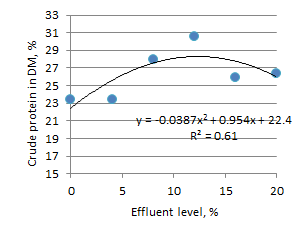Effect on duckweed composition of
different levels of biodigester effluent in the growth medium and of
transferring nutrient-rich duckweed to nutrient-free water
Dang Thi My Tu, Nguyen
Thi Kim Dong* and T R Preston**
Department of Agriculture Science, Mekong University, Vietnam
tudangmk@yahoo.com
*Department of Agriculture and Applied Biology, Cantho
University, Vietnam
**TOSOLY, AA#48,
Socorro, Santander, Colombia
Abstract
Two experiments were conducted on a prívate farm
in Binh Thuy District, Cantho City to study: (i) the yield and composition of
duckweed cultivated with different levels of biodigester effluent;
and (ii) the effect on duckweed composition of a “shock” treatment of
transferring high quality duckweed to plain water containing no nutrients. In
experiment 1, the treatments were 6 levels (0 4, 8, 12, 16 and 20%) of
biodigester effluent added to fresh water in plastic containers containing
duckweed. The
surface of water in each container was 0.4 m2 with
20 cm depth giving a volume of 60 liters.
Duckweed was inoculated at a rate of 400 g/m2.
The yield of duckweed was measured over a period of 14 days by removing
and weighing one third of the biomass every 48h.
There was a curvilinear response in yield, and
in crude protein content of the duckweed, to level of effluent with maximum
values for both at a ratio of 12% effluent and 88% water (Figures 1 and 2).
Duckweed from this treatment was then transferred to fresh water and the
composition studied over 5 days. The content of starch increased and that of
crude protein decreased with increasing time in the fresh water (Figures 3 and
4).
It was concluded that yield and crude protein
content of duckweed was optimized when the culture medium contained 12%
biodigester effluent and 88% water. The “shock” treatment of transferring the
best quality duckweed to nutrient-free fresh water led to decreases in crude
protein and corresponding increases in starch; however, the effects were
relatively small and unlikely to have significance from the points of view of
duckweed as a feed for ducks or as a substrate for ethanol production.
Key words: biomass, ethanol, ducks, protein,
shock, starch
|

|

|
|
Figure 1.
Relationship between effluent concentration and biomass yield of
duckweed |
Figure 2.
Relationship between effluent concentration and crude protein
content of duckweed |
|

|

|
|
Figure 3.
Relationship between time exposed to nutrient-free water and starch
content of duckweed |
Figure 4.
Relationship between time exposed to nutrient-free water and crude
protein content of duckweed |



